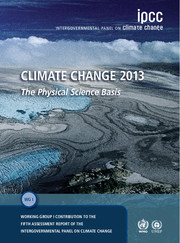 Climate Change 2013 – The Physical Science Basis
Climate Change 2013 – The Physical Science Basis Published online by Cambridge University Press: 05 June 2014
Executive Summary
This chapter assesses the scientific literature describing expectations for near-term climate (present through mid-century). Unless otherwise stated, ‘near-term’ change and the projected changes below are for the period 2016–2035 relative to the reference period 1986–2005. Atmospheric composition (apart from CO2; see Chapter 12) and air quality projections through to 2100 are also assessed.
Decadal Prediction
The nonlinear and chaotic nature of the climate system imposes natual limits on the extent to which skilful predictions of climate statistics may be made. Model-based ‘predictability’ studies, which probe these limits and investigate the physical mechanisms involved, support the potential for the skilful prediction of annual to decadal average temperature and, to a lesser extent precipitation.
Predictions for averages of temperature, over large regions of the planet and for the global mean, exhibit positive skill when verified against observations for forecast periods up to ten years (high confidence). Predictions of precipitation over some land areas also exhibit positive skill. Decadal prediction is a new endeavour in climate science. The level of quality for climate predictions of annual to decadal average quantities is assessed from the past performance of initialized predictions and non-initialized simulations. {11.2.3, Figures 11.3 and 11.4}
In current results, observation-based initialization is the dominant contributor to the skill of predictions of annual mean temperature for the first few years and to the skill of predictions of the global mean surface temperature and the temperature over the North Atlantic, regions of the South Pacific and the tropical Indian Ocean for longer periods (high confidence).
To save this book to your Kindle, first ensure [email protected] is added to your Approved Personal Document E-mail List under your Personal Document Settings on the Manage Your Content and Devices page of your Amazon account. Then enter the ‘name’ part of your Kindle email address below. Find out more about saving to your Kindle.
Note you can select to save to either the @free.kindle.com or @kindle.com variations. ‘@free.kindle.com’ emails are free but can only be saved to your device when it is connected to wi-fi. ‘@kindle.com’ emails can be delivered even when you are not connected to wi-fi, but note that service fees apply.
Find out more about the Kindle Personal Document Service.
To save content items to your account, please confirm that you agree to abide by our usage policies. If this is the first time you use this feature, you will be asked to authorise Cambridge Core to connect with your account. Find out more about saving content to Dropbox.
To save content items to your account, please confirm that you agree to abide by our usage policies. If this is the first time you use this feature, you will be asked to authorise Cambridge Core to connect with your account. Find out more about saving content to Google Drive.